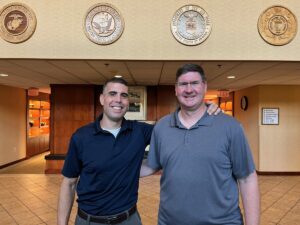
WASHINGTON (BP)–Pro-life bioethicists have applauded the announcement of a new advance in stem cell research that is a safer and more efficient method than previously discovered methods and avoids experiments that destroy human embryos.
Scientists at the Harvard Stem Cell Institute in Boston, Mass., published studies showing they had reprogrammed adult skin cells into induced pluripotent stem (iPS) cells without the hazards previously associated with the technique. Unlike previous conversions of adult cells into stem cells virtually identical to those in embryos, these iPS cells did not require the use of viruses to insert genes into cells — a technique which increases the risk of cancer in the recipient of the cells.
The new method also avoided the ethical problems of embryonic stem cell research (ESCR), which requires the destruction of days-old human embryos when extracting the cells.
ESCR opponents said the development further demonstrates the destructive research method — which is funded by the federal government — is not only morally repugnant but unnecessary.
“This is yet another confirmation that when science takes the moral high ground great discoveries can be made,” said C. Ben Mitchell, professor of moral philosophy at Union University in Jackson, Tenn., and a consultant to the Southern Baptist Ethics & Religious Liberty Commission.
“Even some of the most skeptical proponents of embryo-destructive research are getting the message,” Mitchell told Baptist Press. “There are no good reasons to kill human embryos for research. Human embryos belong in a mother’s body, not in a research lab.”
Richard Doerflinger told The Washington Post, “With each new study it becomes more and more implausible to claim that scientists must rely on destruction of human embryos to achieve rapid progress in regenerative medicine.” Doerflinger is associate director of the Secretariat of Pro-Life Activities at the U.S. Conference of Catholic Bishops.
David Stevens, the Christian Medical Association’s chief executive officer, said the new research “should put one of the final nails in the coffin of federally funded embryonic stem cell research. This breakthrough is further evidence that the government’s illegal funding of embryo-destroying research is like investing in vinyl record technology in a digital age.”
ESCR advocates, however, continued to call for government funds for destructive research using embryonic cells.
Francis Collins, director of the National Institutes of Health (NIH), commended the new study as “a substantial advance” but said the new iPS research must be compared to ESCR. “To explore these important potential differences, iPS research must continue to be conducted side by side with human embryonic cell research,” he told The Post.
The discovery was announced as a battle over government funding of ESCR is being fought in the federal judiciary
Two days before the Harvard researchers issued their Sept. 30 report, the District of Columbia Circuit Court of Appeals ruled federal funding of ESCR may continue while a legal challenge is considered.
D.C. federal judge Royce Lamberth had halted the grants Aug. 23 because a lawsuit against NIH guidelines on ESCR had “a strong likelihood” of succeeding. On Sept. 7, Lamberth rejected the Obama administration’s request that he revoke his stay. The administration then took its case to the appeals court.
In his injunction stopping funding of ESCR, Lamberth found NIH’s 2009 guidelines violated a 1996 law that prohibits federal funds for research in which a human embryo is destroyed. NIH’s rules allow funding for research on stem cells derived from embryos created by in vitro fertilization but not implanted. The embryos have to be donated by the parents who underwent the fertility treatments.
NIH published the guidance after President Obama issued an executive order earlier in 2009 overturning a more restrictive funding policy and ordering the institute to draft guidelines consistent with his decree. Obama’s executive order overturned a prohibition instituted by President Bush on federal funding of stem cell research that results in the destruction of embryos. Bush’s 2001 order permitted, however, grants for experiments on stem cell lines, or colonies, already in existence at the time of his action.
The ability of stem cells to convert to other cells and tissues has provided great hope for developing cures for various diseases.
ESCR is not only lethal to the embryo, but it has not proven as effective as other forms of stem cell experimentation that do not harm the donor. It has yet to provide any treatments for human beings and has been plagued by tumors in lab animals.
Embryonic stem cells are pluripotent, which means they, in theory, can convert into any type of cell or tissue. Adult stem cells are not. Yet, research with adult cells in human trials has produced therapies for 73 afflictions, including cancer, juvenile diabetes, multiple sclerosis, heart damage, Parkinson’s, sickle cell anemia and spinal cord injuries, according to Do No Harm, a coalition promoting ethics in research.
Experiments with iPS cells using earlier methods since 2006 have demonstrated promising results and generated a great deal of interest among scientists. Their safety has been questioned because of the use of viruses, and their conversion also has been slow.
The Harvard team found its method was about twice as fast in converting the skin cells into iPS cells and as much as 100 times more efficient, according to The Post.
Instead of viruses, the researchers created molecules referred to as “messenger RNA” to produce proteins necessary for reprogramming the cells into iPS ones, The Post reported. The scientists also used the technique to convert the iPS cells into specific cells that may be used in transplants, according to the newspaper.
Stem cell researchers hailed the results.
“All I can say is ‘wow’ — this is a game-changer,” said Robert Lanza of Advanced Cell Technology (ACT) in Worcester, Mass., The Post reported. “It would solve some of the most important problems in the field.”
Describing the method as “almost too good to be true,” Lanza said, “The ability to safely and efficiently generate patient-specific cells has the potential to transform transplantation medicine.”
The study was published in the journal Cell Stem Cell.
–30–
Compiled by Tom Strode, Washington bureau chief for Baptist Press.














